What Are SEO Ecommerce Category Pages?
SEO ecommerce category pages organize, showcase, and optimize a group of products that have similar uses or attributes on an ecommerce website or online store.
A category page serves as a hub for users to navigate to individual product pages on a website easily. By following product page links from this single page, search engines are also able to discover and index new products quickly.
If you think of an ecommerce store as a physical store, category pages are like individual departments. If you're shopping for footwear at a store, you'd go to the shoe section. On an ecommerce site, you'd go to the shoe category page.
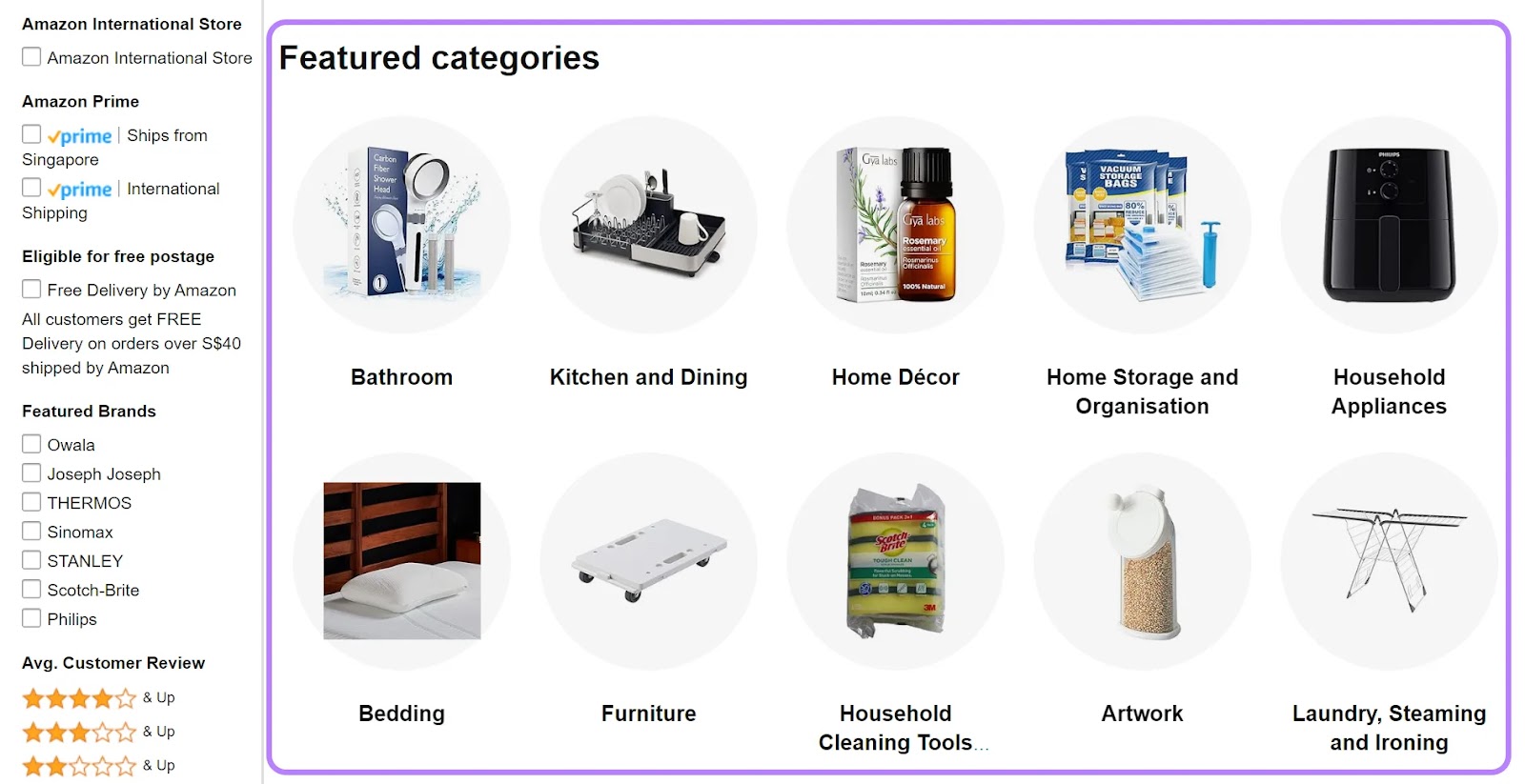
Since category pages organize internal linking by linking to all individual product pages in a group, they help search engines understand how different pages relate to each other. This can help with SEO.
By optimizing your ecommerce category pages for SEO, you increase the chances that people searching for products you sell will find your online store, bringing more potential customers your way.
Why Are Ecommerce Category Pages Important for SEO?
Aside from helping search engines crawl your site, category pages help you target search queries for broader search terms, such as “shoes” or “buy shoes.”
Broader keywords like "buy shoes" tend to have a high transactional intent (which means users are likely looking to buy a product), so they can boost revenue.
Typically, they also have higher search volumes than the long-tail keywords targeted by product pages. So, if your category pages rank, it can bring you more traffic.
A search for broad search terms often shows category pages in search engine result pages (SERPs).
For example, if you type “shoes” in Google, you’ll see SEO category pages like this:
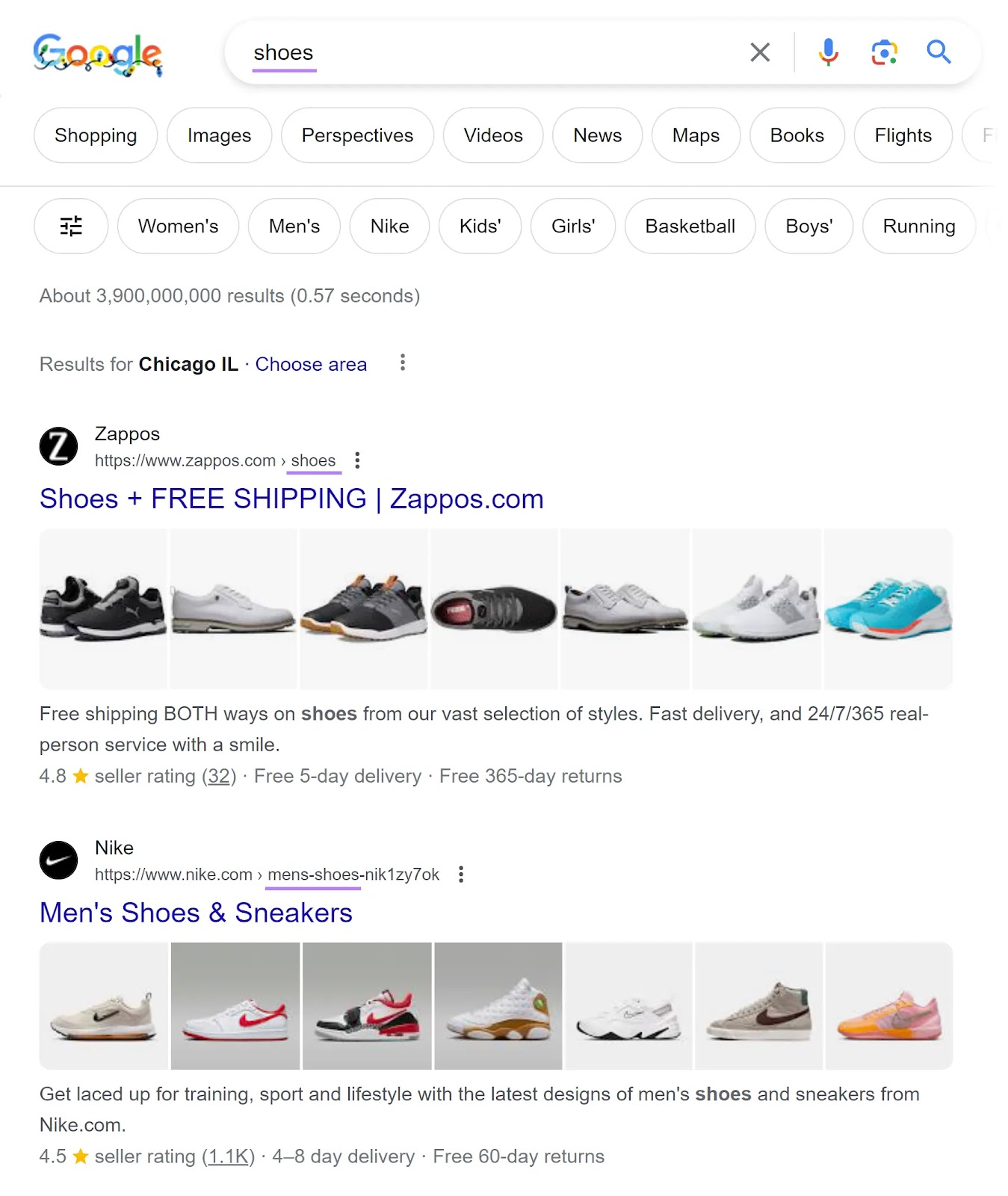
Now, try typing “dresses online” into Google—you can see more examples of SEO ecommerce category pages this way.
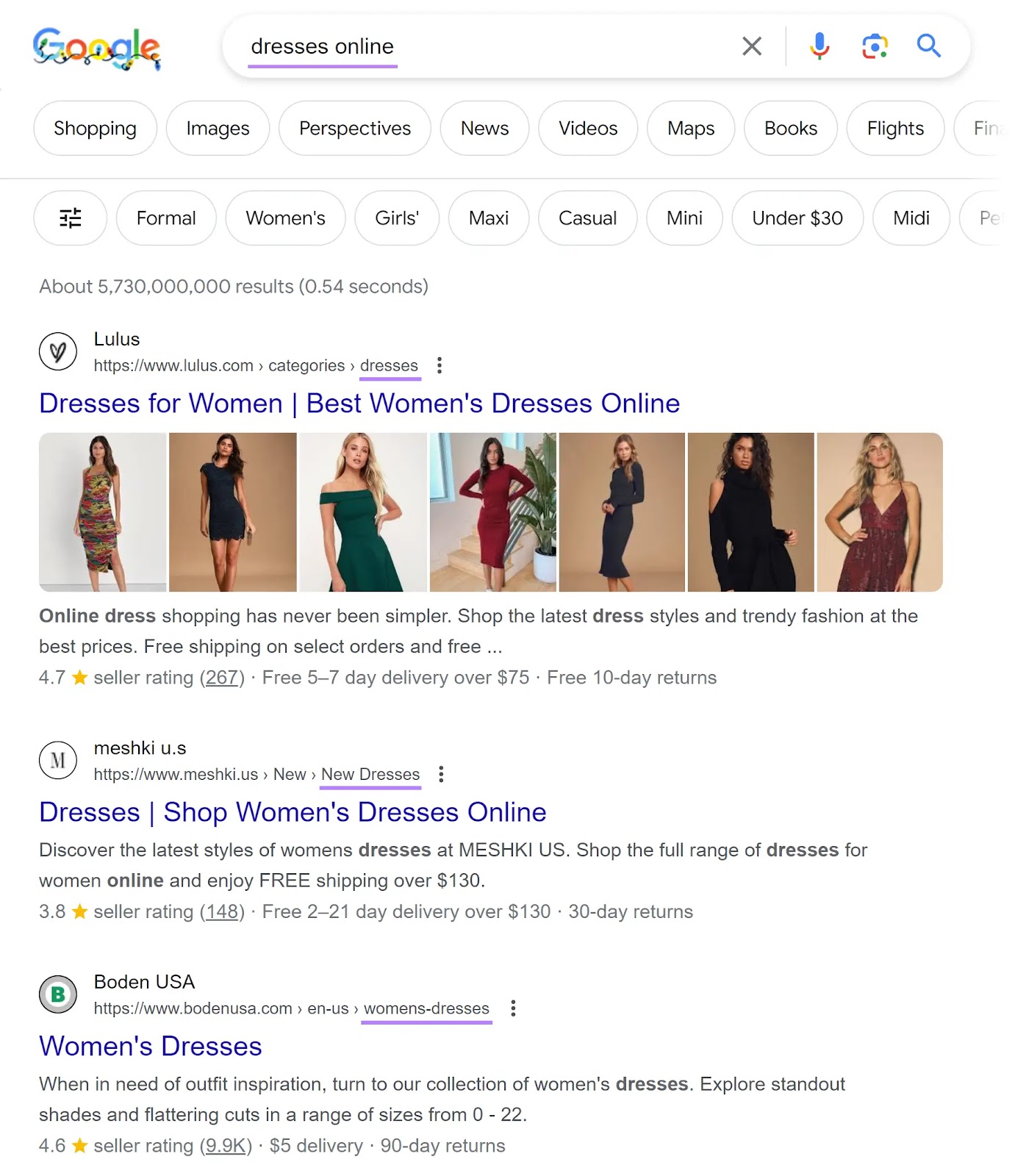
How to Optimize Ecommerce Category Pages
There are three types of SEO: technical SEO, on-page SEO, and off-page SEO.
Ecommerce category page best practices include improving technical aspects such as page speed (technical), building more links (off-page), and enhancing on-page elements with keyword-rich content that helps users (on-page).
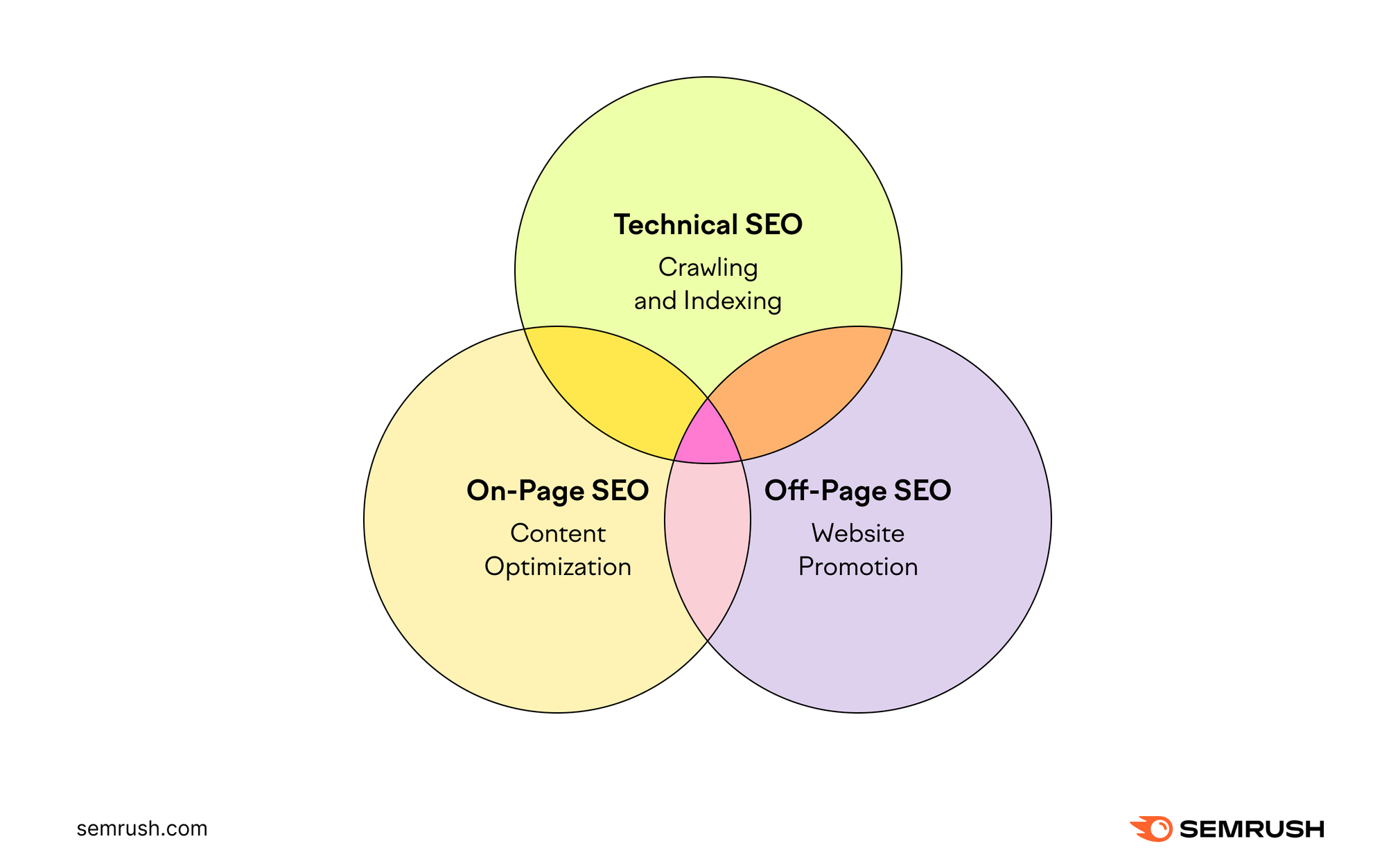
Here’s how to optimize your ecommerce category pages’ SEO structure, enhance on-page elements, and improve technical SEO.
Structure Your Category Pages
Structuring category pages for an ecommerce website means organizing and presenting products in a way that enhances user experience and facilitates easy navigation.
Create an SEO-friendly category page structure with these best practices:
1. Organize Categories Logically
The primary purpose of category pages is to help users find the right product quickly.
When shoppers can't find what they want with minimal effort, they are more likely to leave your website. Thirty-seven percent of users from Europe and the U.S. cite poor navigation and layout as one of the main reasons for abandoning an ecommerce site.
Start by analyzing your entire product catalog and group products based on commonalities. Sort products into general categories first, then place them in more specific ones.
For example, you might feature “dining table” and “bed” on a “Furniture” category page. But you can also feature them under more specific categories such as “living room furniture” and “bedroom furniture.”
Also, consider how users search for products. If they wanted to refurbish a specific room in their home, would they search for "furniture?" Creating subcategories like “bedroom furniture” can better satisfy your user’s search intent.
Here’s an example of how to organize an electronics ecommerce website:
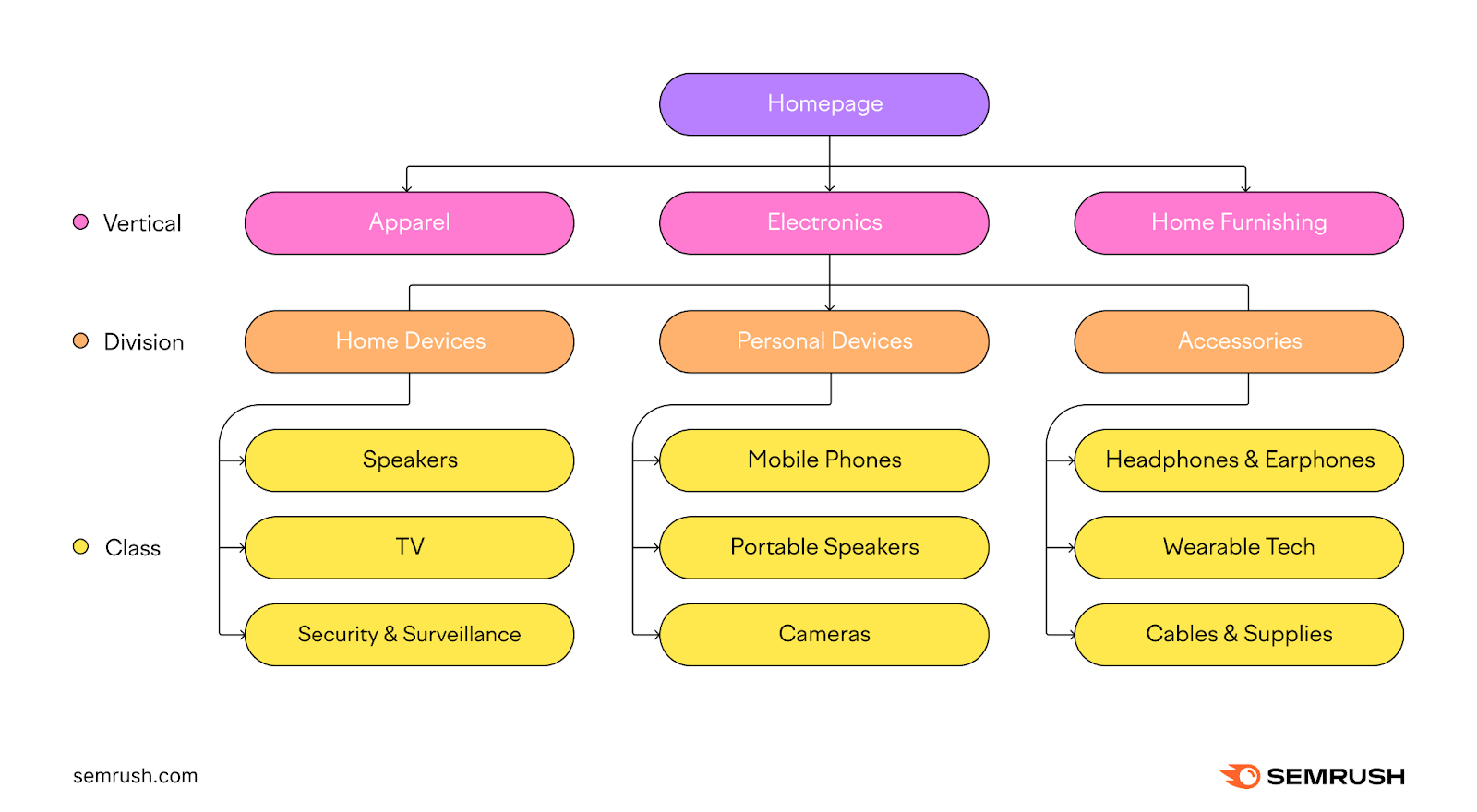
Further reading: 11 Great Examples of Ecommerce Navigation That Can Improve Sales
2. Create Long-Tail Categories
Long-tail category pages focus on unique or specialized products within a broader category.
They typically have lower search volumes since they cater to a targeted audience. But it can still be profitable to target them, as specific search queries usually convert more than broader ones.
According to a study conducted by the SEO agency Embryo, long-tail keywords have a conversion rate of 36%, while short-tail keywords have a conversion rate of 11.5 percent.
With long-tail keywords, search engines can more readily comprehend a searcher's intent and deliver relevant results.
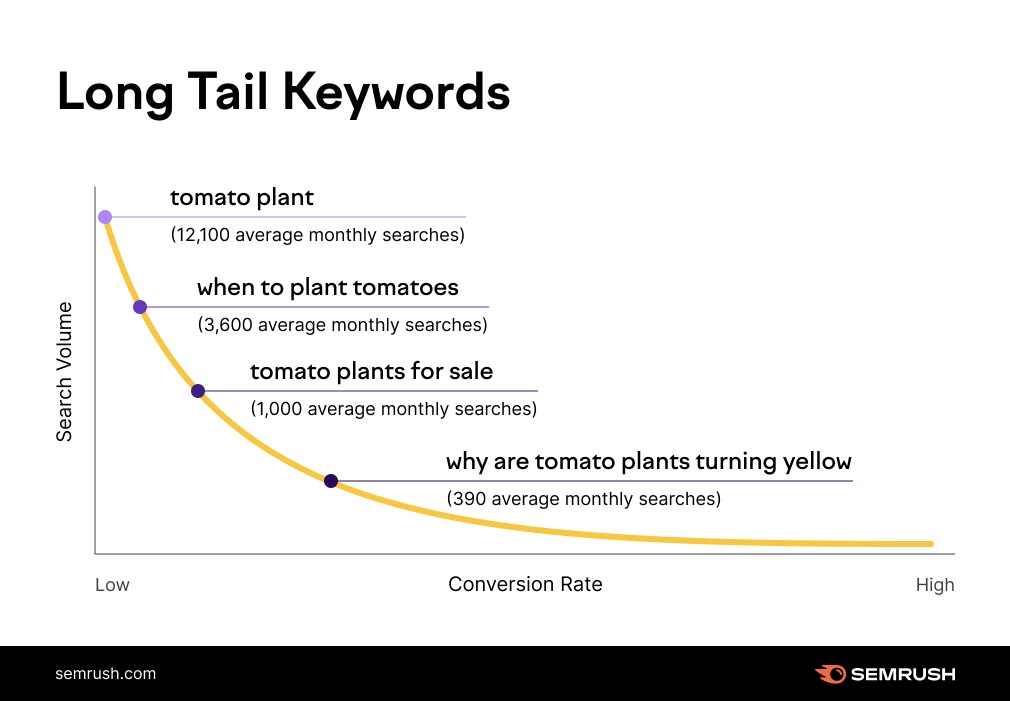
Are you selling a specialized product in a specific niche? Use long-tail category pages to capitalize on the demand for unique products or categories.
Here’s an example of a website that did this successfully:
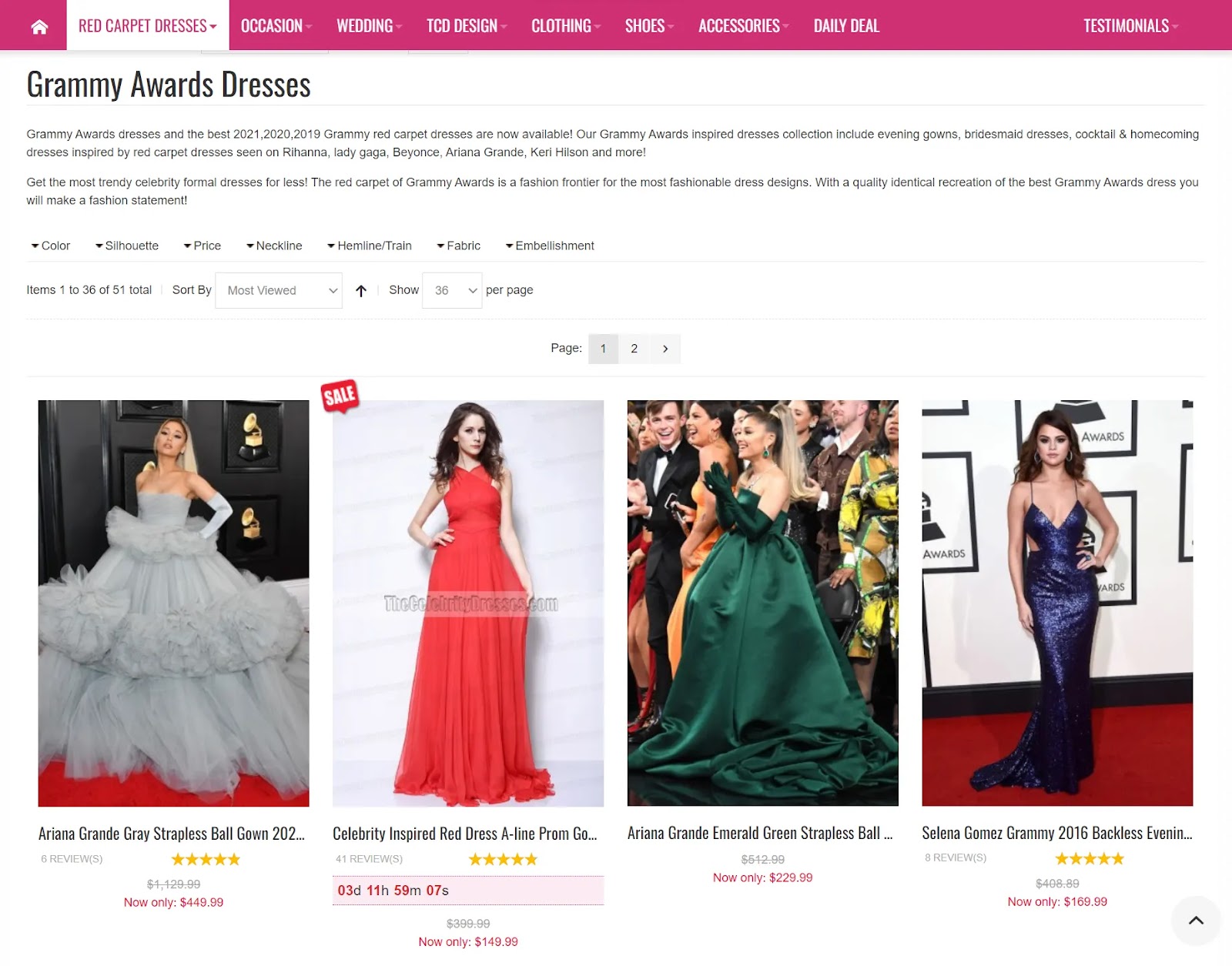
This SEO category page from TheCelebrityDresses.com targets the keyword “buy Grammy awards dresses.” It even ranks higher than established ecommerce stores like Etsy.
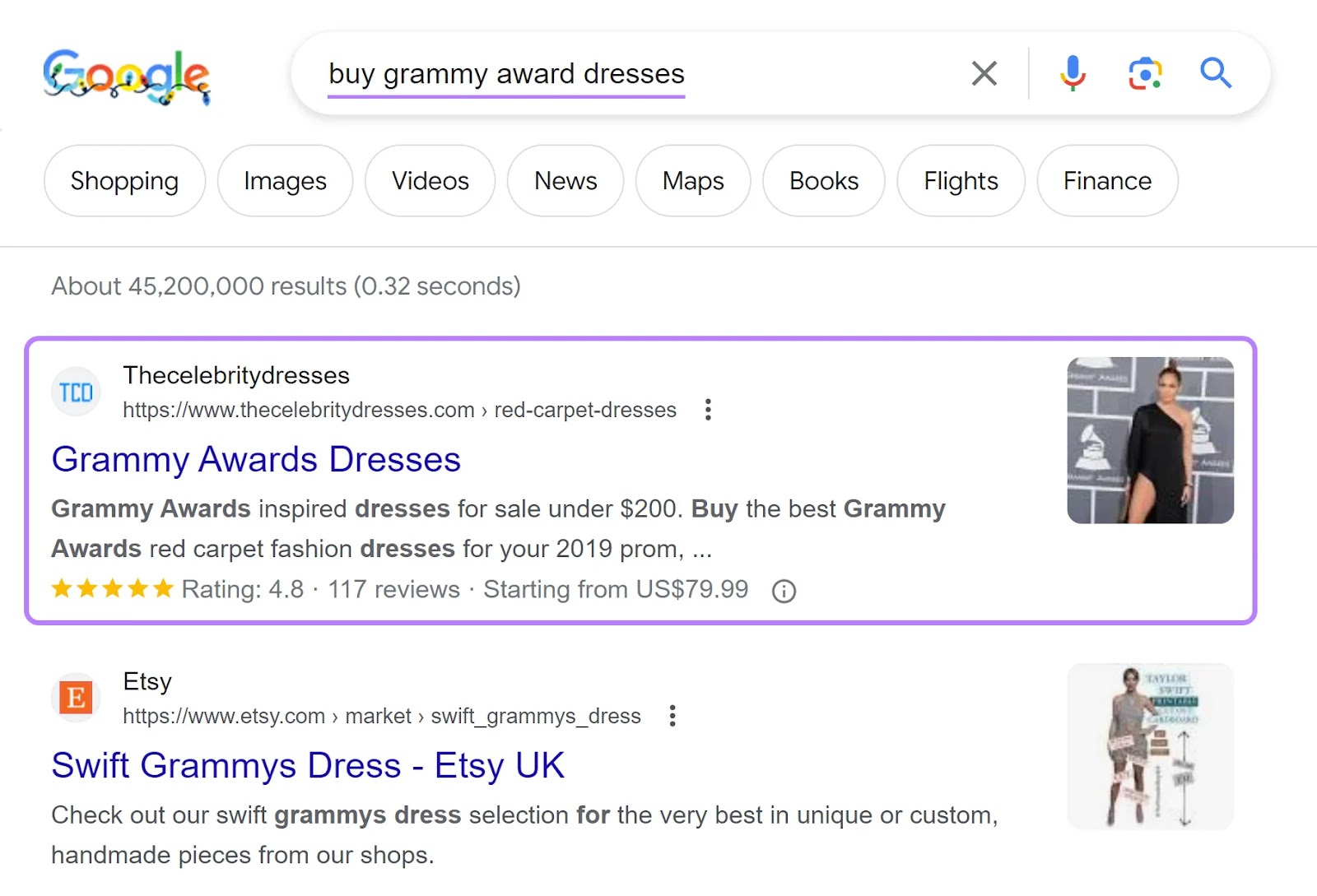
Lastly, create long-tail categories if you want users to find your SEO ecommerce category pages in voice searches.
Users who interact with AI voice assistants like Siri or Google Voice Assistant typically use conversational language or ask questions. These queries are specific, so they likely include long-tail keywords.
Since 58% of U.S. smartphone users use voice search to find information about products and services, ranking for those queries has the potential to significantly boost your SEO ROI.
Struggling to find niche long-tail keywords to create specialized category pages? Use the Semrush Keyword Magic Tool.
Here’s how:
After logging into your Semrush suite, go to the “Keyword Magic Tool.”
Inside the search bar, input your broader product category. In this example, we used “dresses.” Then, click “Search.”

The tool will generate terms related to your search. From the “Intent” drop-down menu, select “Commercial” and click “Apply.”
This way, your keywords will mostly target people who are actively looking to buy stuff.
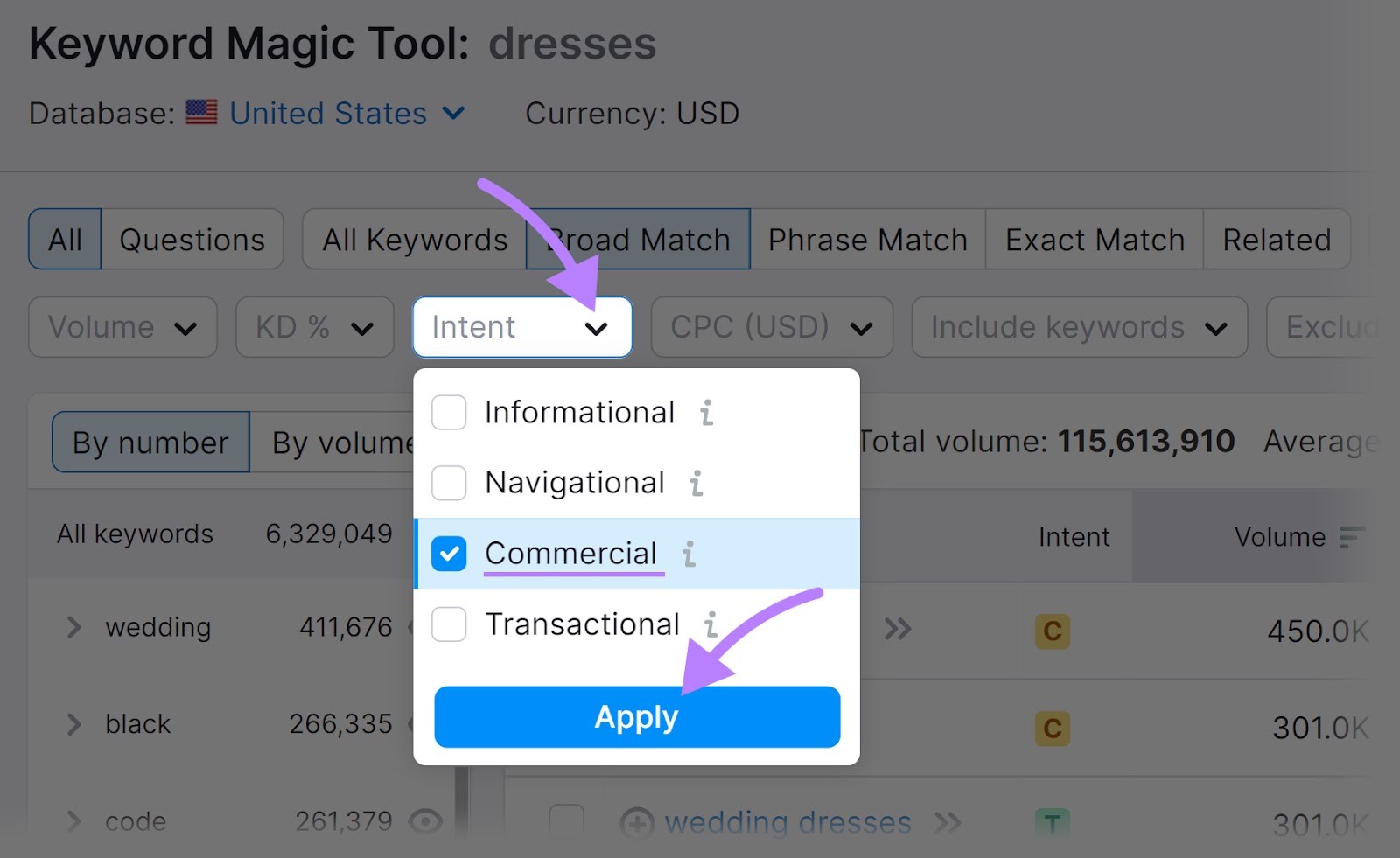
Then, sort the list for ascending search volume by clicking the “Volume” tab in the bar. You can also sort the list for ascending “KD%” (keyword difficulty) to identify keywords that are easier to rank for.
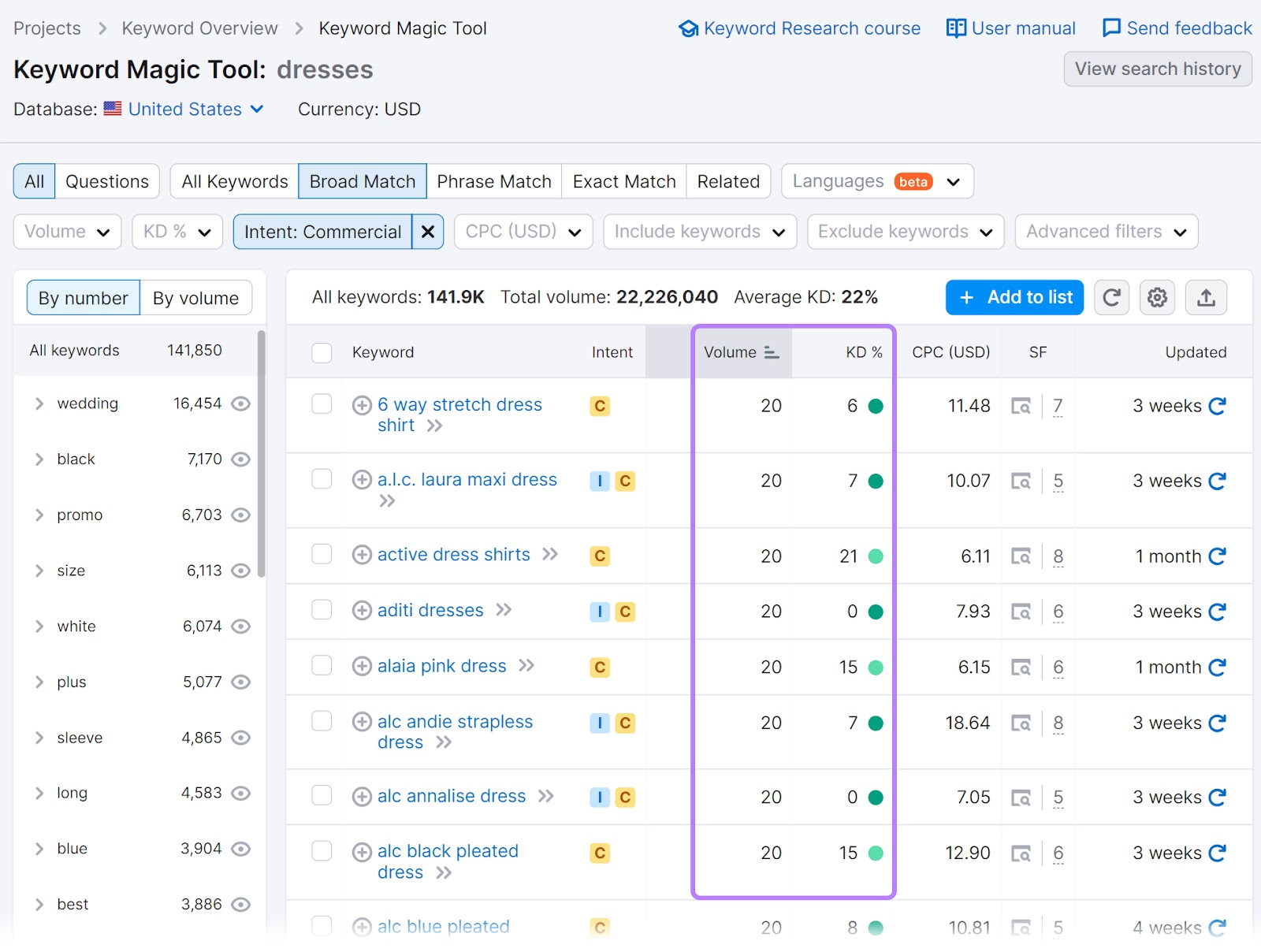
Finally, you’ll see a list of primarily long-tail keywords. Scan the list and figure out which keywords could become a website category.
For example, in this list, “athletic cut men’s dress shirts” and “athletic stretch dress shirts” can be viable niche categories.
Select the ones relevant to your ecommerce website.

Finally, export these keywords by clicking the “Export” button and choosing your preferred format.

3. Build a Hierarchy with Category URLs
Category URLs help you organize and connect individual product pages to the home page.
Doing so reduces crawl depth (or the distance a search engine crawler needs to travel from the home page to reach other pages on your website). It also indicates the number of clicks it would take to reach a specific page.
For example, if the pathway to your product page is Home > Category page > Product page, the crawl depth is three.
When the crawl depth is less than three, search engines will crawl and index more of your pages in less time.
Search engines allocate limited resources (called crawl budget) to each website. If the Googlebot cannot crawl your website or has to crawl it more often due to errors, it could delay the indexing of your pages—if they get indexed at all.
Use different URL paths to make your website architecture clear to search engines.
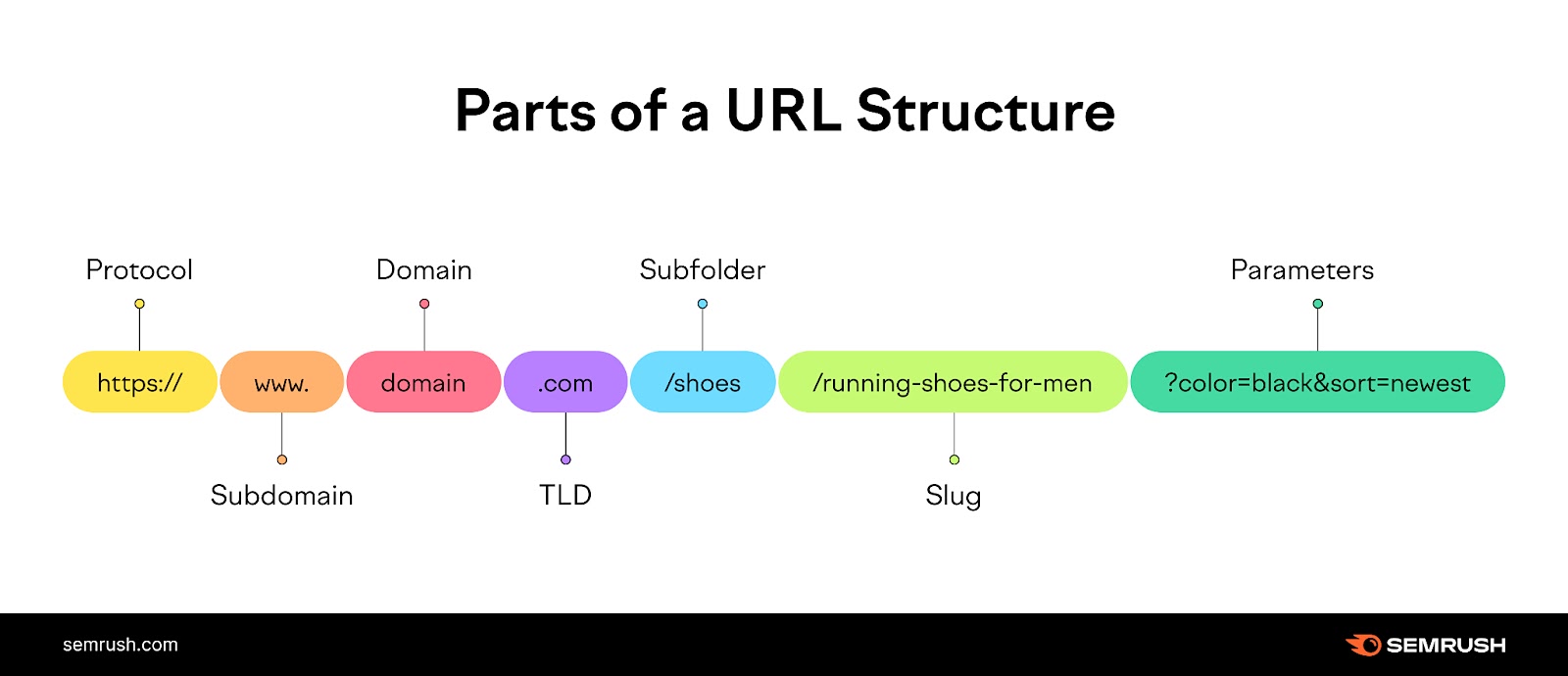
Here are some tips:
- Use “subfolders” in URLs to organize your products in broad categories. Example: www.example.com/shoes.
- Create as many subfolders as necessary to create a logical URL path. Use the same principle when creating product categories—go from general to more specific subfolders. For example, if you have a long-tail category page under “shoes," your URL path will look like this: www.example.com/shoes/sneakers or www.example.com/shoes/outdoor-shoes.
- Use unique slugs for different product pages. Make sure the slug captures the attributes of the product. Example: www.example.com/shoes/outdoor-shoes/nike-red-running-shoes
- Show a breadcrumb trail that allows users to revisit pages from their search journey
Further reading: How to Build Your Website Architecture for SEO
4. Pick a Faceted Navigation Strategy
Faceted navigation refers to filters on SEO ecommerce category pages. Shoppers use it to narrow their product search by attributes like size, price, color, ratings, material, etc.
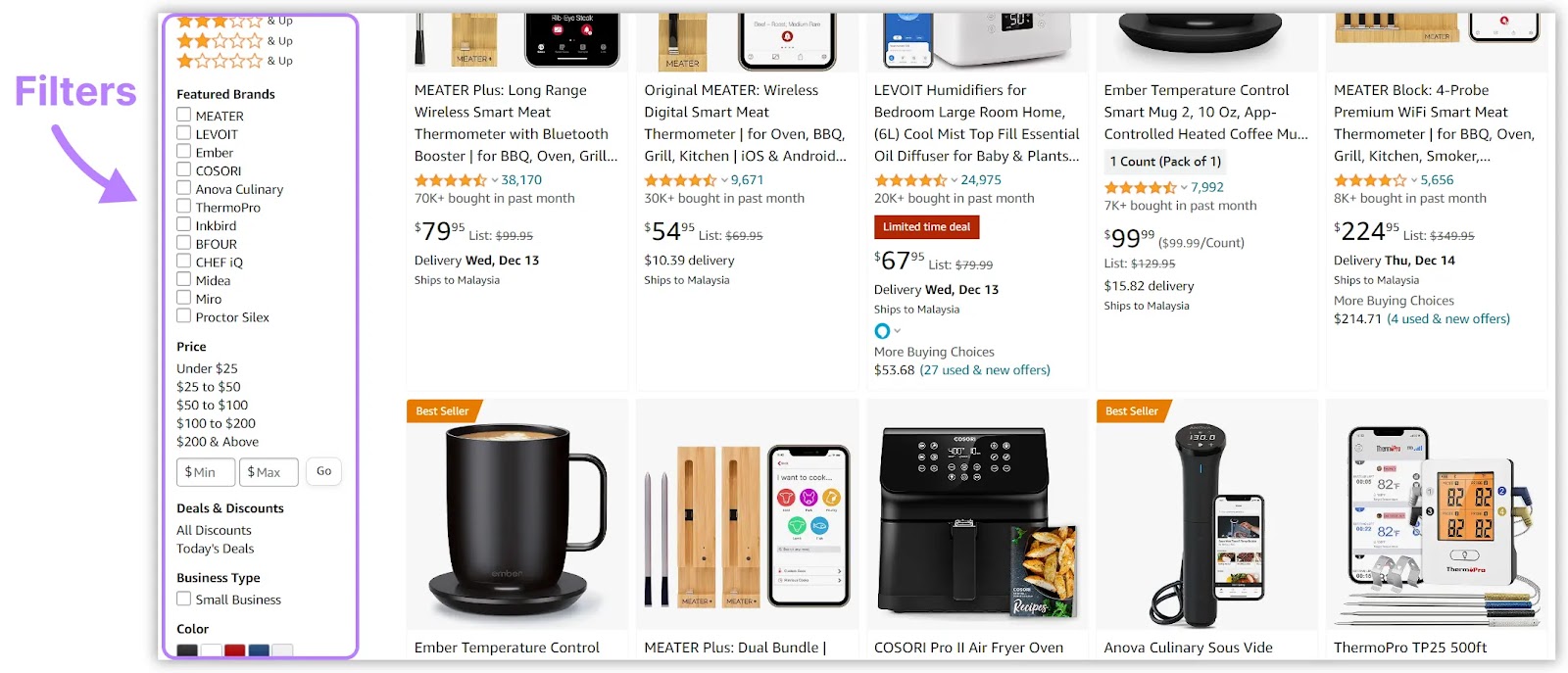
“Filters” allow shoppers to find relevant products quickly, which can boost conversions by up to 26 percent.
Avoid URL combinations that can negatively affect your category page SEO. Search engines won't know which URL to index if your faceted navigation includes multiple URL combinations that display the same products.
Take the image below, for example. Each filter adds a different URL parameter on top of the base URL.
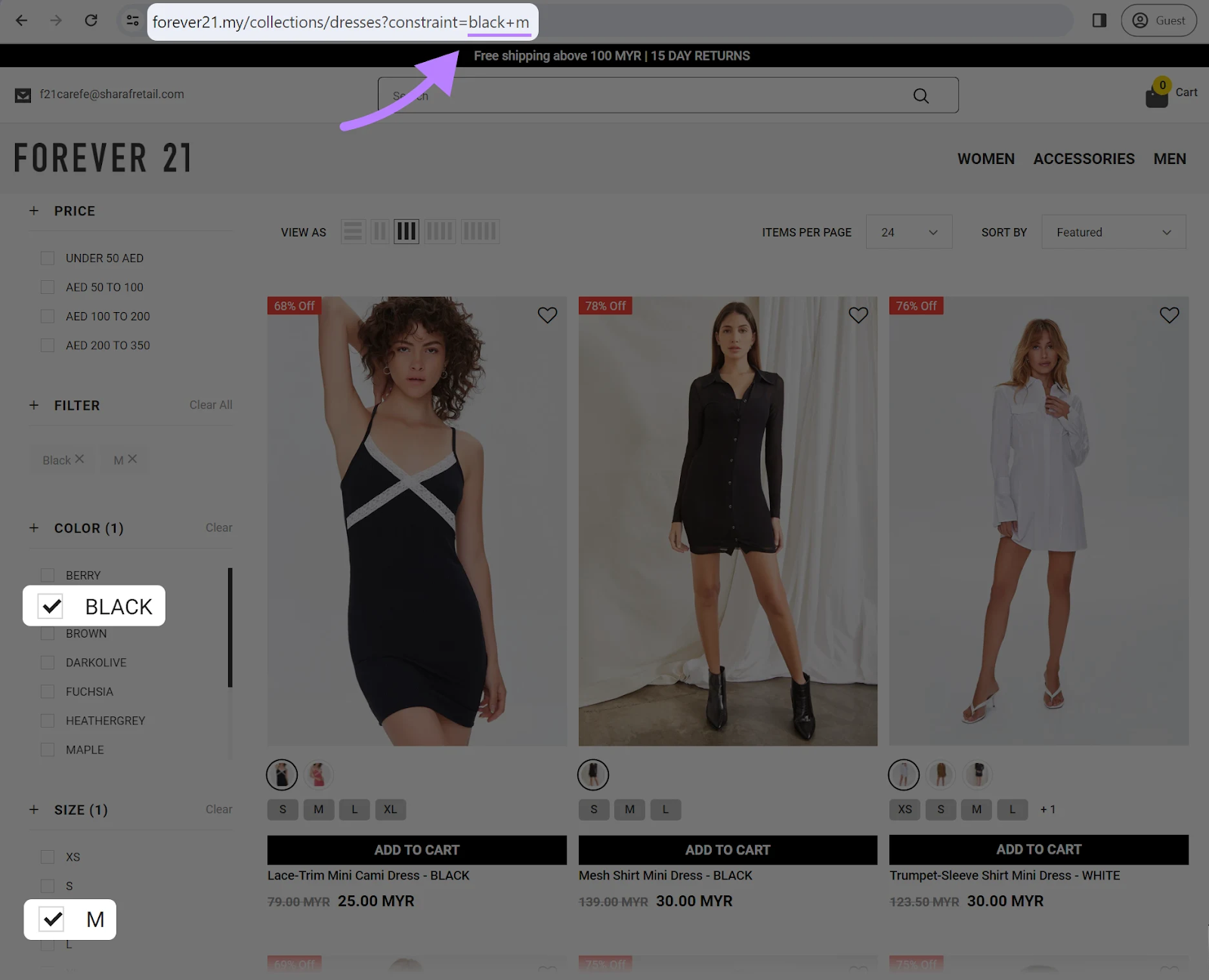
The base category page URL is https://forever21.my/collections/dresses. If you sort by size, the URL becomes https://forever21.my/collections/dresses?constraint=m.
When you sort by size, color, and material, the URL will look like this: https://forever21.my/collections/dresses?constraint=m+black+knitwear_women.
However, URL combinations like these can waste crawl budgets and might make it harder for search engines to discover new products.
They may also not add any value for Google searchers. For instance, users don’t search for products like: “M-sized knitwear dresses in black from Forever21, priced between $50 to $100.”
How do you manage these URL combinations?
- Use robots.txt to stop search engines from indexing these faceted URLs
- Discourage search engines from following internal links to faceted URLs by adding a no-follow directive
Enhance On-Page Elements
Enhancing on-page elements (or on-page SEO) means improving elements on a page that both search engines and human beings can read. For instance, an H1 tag can be read by both.
Here’s how you can improve on-page elements for SEO ecommerce category pages:
1. Add Helpful Content
Add relevant keyword-focused category page content to improve your chances of ranking.
Your content should match the purpose of your category page and encourage users to ultimately find the product they want to purchase. Answer questions about how you curate items for your website, what kind of materials you use, etc.
For instance, if your company sells skiing equipment, you could include the following information on your category pages:
- How you choose products for your catalog (based on safety standards or efficiency)
- How you source your materials
- Your best-selling items in that category or expert recommendations for skiers of different skill levels
- Your manufacturing and delivery process
2. Use Your Copy Wisely
There is a limited amount of space on a category page. The copy shouldn’t crowd the page or distract shoppers from browsing your product collection.
A standard practice includes adding some text right after the hero banner or the H1 tag.
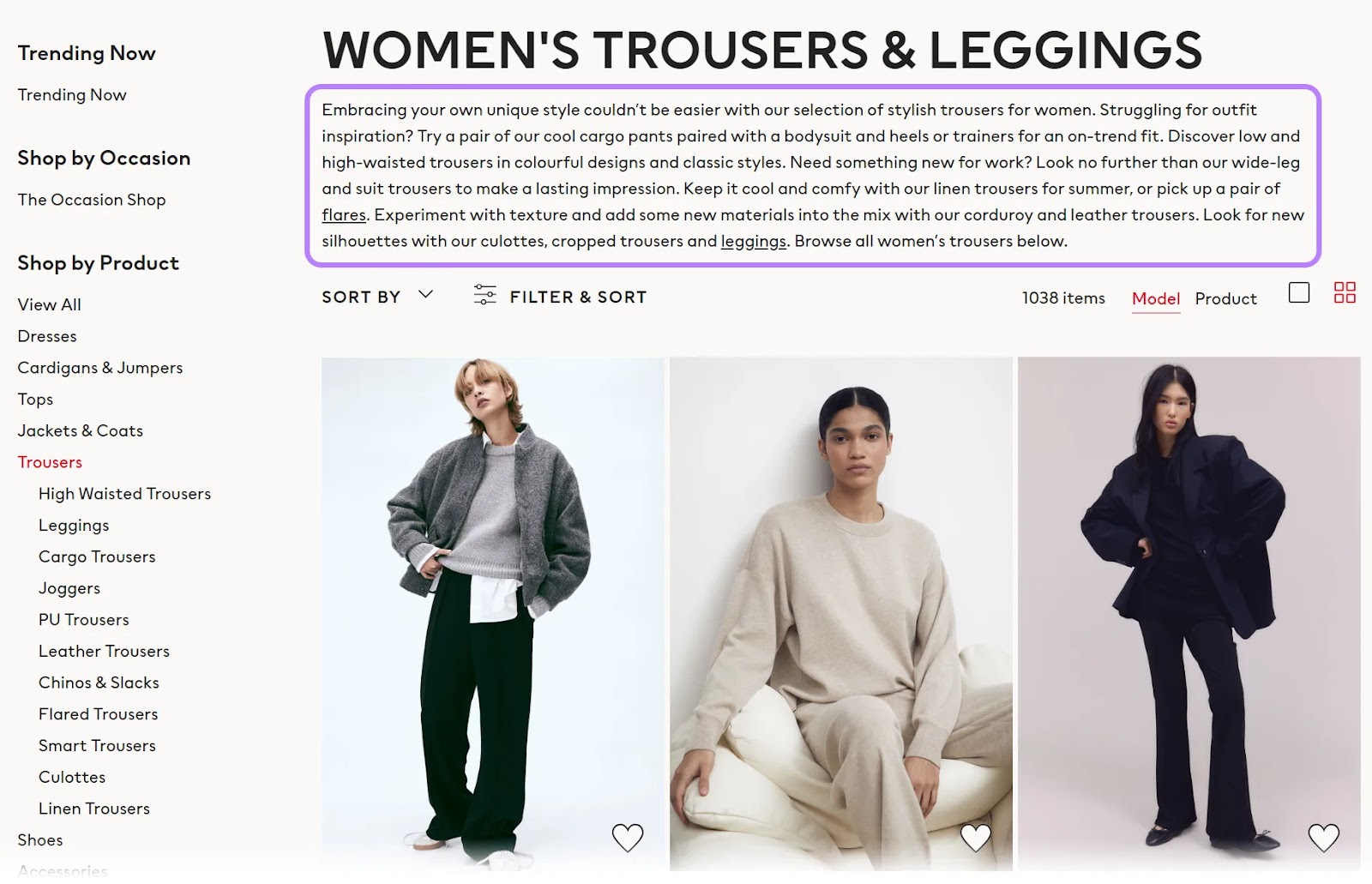
You can also answer more specific questions about your product line with content at the bottom of the category page. This typically means adding a frequently asked questions (FAQs) block.
Also, your copy should be easily scannable and resonate with your audience. Use the principles of effective copywriting to write copy that does the selling for you. Include CTA buttons to encourage customers to take the desired steps, such as exploring featured products.
3. Answer User Questions
When you visit a shop with a physical location and have questions, what do you do? You ask the staff for more information.
Because online shoppers don't have that option, include FAQs in each product category to guide the user. Address questions about your quality assurance process, materials, or manufacturing process. Provide recommendations for popular products.
Answering customers' questions can build trust in your business, resulting in higher conversions.
For example, a recent analysis showed that when customers interacted with Q&A sections, ecommerce sites saw a 157.1% increase in conversion rates.
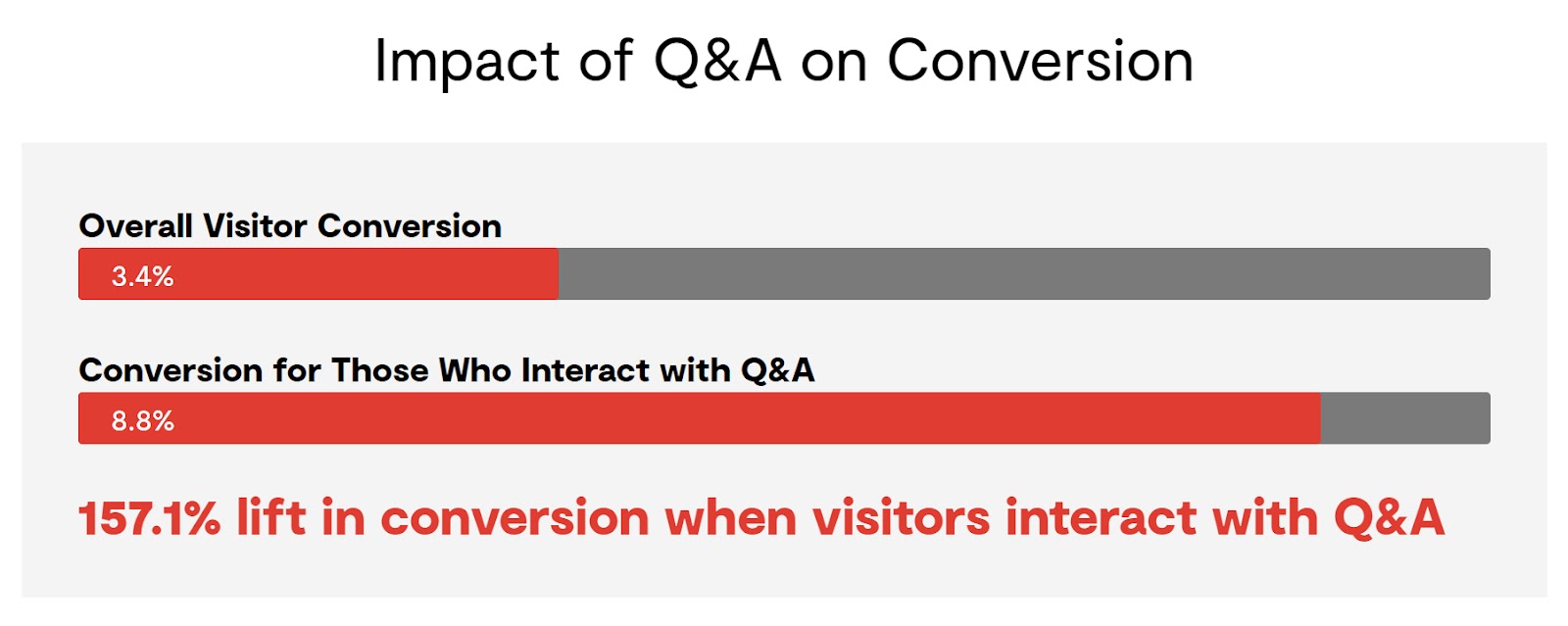
4. Add Reviews and Useful Guides
Positive reviews become trust signals for shoppers. They give customers confidence when making a purchase, which can increase conversion rates.
But how effective are reviews? Over 99.9% of users read product reviews to make purchasing decisions, and 84% trust reviews as much as recommendations from friends and family.
Reviews are also key for SEO. Ecommerce product category pages can appear in search results accompanied by a star rating, which makes your SERP listing stand out, increasing click-through rates.
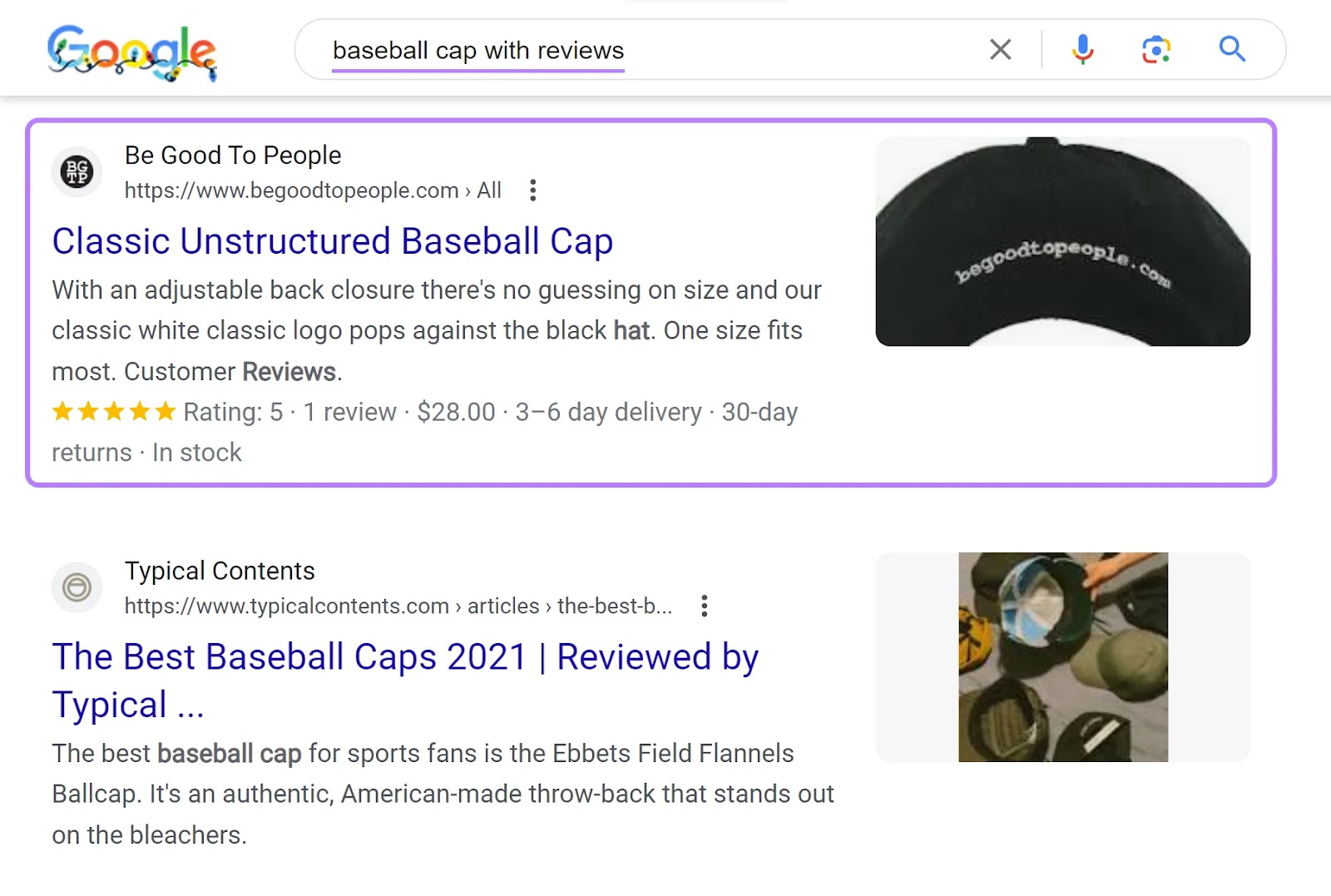
Linking to in-depth product guides from category pages can also help with SEO, as there’s evidence that Google treats internal links as ranking factors. A well-thought-out and optimized internal linking structure helps search engine crawlers understand a page's content.
Additionally, linking to helpful guides that offer shoppers product information and recommendations increases the visibility of those blog posts.
Improve Technical Aspects
Enhancing technical aspects of an ecommerce site involves improving behind-the-scenes functionality.
This includes improving website speed, ensuring mobile responsiveness, implementing secure payment gateways, and enhancing overall site reliability. The objective is to improve your website's SEO and provide a better shopping experience for users.
Here are a few technical aspects you can improve for product category pages:
1. Pick an Optimal URL Structure
An optimal URL structure ensures both search engines and users understand what a page is about. Use URL best practices when creating URLs to optimize your pages.
Here are some tips for creating SEO-friendly URLs:
- Standardize the sentence case: Search engines might consider example.com/abc and example.com/ABC as different URLs even though they include the same words. You could also make internal linking errors if you link to the wrong version. It’s best to keep the URLs lowercase to avoid SEO issues.
- Use keywords in category subfolders: Google’s John Mueller confirmed that keywords in URLs are a ranking factor
- Don’t add unnecessary words: Avoid using stop words (i.e., the, in, a) and unnecessary punctuation. If your CMS adds words like “/category” in front of each category subfolder, remove it. Rename this to the actual category name instead of using the word "category."
- Avoid using dates and timestamps: They are unnecessary in the URL and may even give the impression that your content needs to be updated. Google recommends avoiding these types of URLs.
- Manage redirects effectively: If you’re working with a product page redirect, a simple redirect to a 404 page or a 301 redirect to the category page should suffice. A change to the top-level URL subfolders may disrupt the entire website hierarchy. Use our redirection guide to learn how to redirect category pages safely.
2. Use H1s and Title Tags Strategically,
H1s and title tags help both users and search engines understand what your page is about. Both should contain the primary keyword you're targeting.
The H1 tag should clearly state the page's primary purpose, so we don’t recommend using more than one H1 tag per page. It can be confusing to both visitors and search engine crawlers.
However, an H1 and title tag doesn’t have to be the same. The H1 tag is located on a website page, whereas a title tag appears in the search engine result pages (SERPs).
Make your title tags compelling enough to encourage more clicks in SERPs.
For example, Zalora advertises its ongoing sales promotions via its title tag. It piques a shopper's curiosity to entice clicks.

3. Optimize Your Category Meta Description
Compel searchers to click on your website instead of a competitor’s by making your meta description a small sales pitch to boost click-through rates.
For example, include customer-attracting phrases such as “free shipping,“ “hassle-free returns,” or “money-back guarantee.”
Apple does a great job in this example:

4. Set the Canonical URLs Correctly
As we discussed previously, faceted navigation can create multiple URL versions of the same base URL.
This can also happen if a product appears in more than one category. Search engines won't know which version to index in search results.
Canonical attributes can fix this issue and tell search engines your preferred URL. This can help consolidate all ranking signals for the canonical version, helping you prioritize its SEO performance.
Add canonical URLs in your website sitemap for best results. Read our canonical URLs guide for a detailed walkthrough.
5. Implement Structured Data
Structured data plays a significant role in ecommerce SEO.
Structured data (or schema) uses Jason-LD vocabulary (a coding script) to provide search engines with explicit information about webpage content.
It provides information about your content to help bots understand the relationships between different page elements.
For SEO ecommerce category pages, use an “ItemList” schema to define product category properties and the products they contain. Defining these properties increases the likelihood of your pages appearing as rich snippets below the main search result.
Here is an example:

If you want to show your website's average rating in results (like the example above), consider adding the “AggregrateRating” schema. For category pages with FAQs, also add FAQ structured data.
6. Avoid Duplication at All Costs
In earlier sections, we covered how duplication issues waste your crawl budget. But that’s not all. Other negative effects can include:
- Keyword cannibalization: Keyword cannibalization occurs when multiple URLs of the same website compete for the same keyword (duplicate URLs). This affects your rankings and visibility in search results.
- Analytics challenges: Tracking website traffic becomes challenging with duplicate URLs. You'll see split traffic and engagement metrics in GA4, which doesn't provide an accurate picture of how your main URL is performing.
Design & Usability
The design of an ecommerce category page should be both attractive and user-friendly. A functional and aesthetic website is easier for users to navigate.
Plus, it’s easier to present products clearly on a well-designed page. This can reduce the friction in the checkout process.
Here are some design best practices for SEO ecommerce category pages:
1. Create a Consistent Layout
Consistent design and layout make navigation predictable for users. Users can anticipate what will happen as they navigate your website.
It’s worth noting that 38% of users look at a page’s layout and top-level navigation on a first visit and may leave the website if they find it confusing to navigate.
When visitors can quickly understand the page structure, find relevant information, and identify the products they are looking for, they enjoy the shopping experience. As customers become familiar with your site's organization, it also reinforces reliability and trust.
A consistent design theme also creates visual harmony across your website, which is a good branding practice.
Having a consistent layout also serves a practical function. When you create a page template, uploading new content doesn't require additional design resources, making it easier to perform site maintenance and updates.
Here’s how you can create a consistent layout:
- Standardize design elements: Keep main design elements like color schemes, fonts, and button styles consistent across all pages
- Create a uniform page structure: Fix the location of navigation menus, product categories, and essential information across the entire website
- Use branded visuals: Use standardized image sizes across all pages and make sure other visuals, like graphics, align with your branding identity
- Make your website responsive: Users shop on all screens and devices. Your website should provide a uniform user experience regardless of screen size.
2. Ensure High-Quality Visuals
Have you ever considered booking on a home-sharing site like Airbnb but changed your mind because the pictures didn't provide enough detail on what the place looks like?
This happens on ecommerce platforms too.
According to Insider Intelligence, 83% of online shoppers find product images “extremely” influential in purchasing decisions. 22% of returns also happen because the products look different from the images.
But how important is image quality? Online Dasher says high-quality images have a 94% higher conversion rate.
3. Don’t Neglect UX (User Experience)
A good user experience (UX) makes the shopping experience enjoyable.
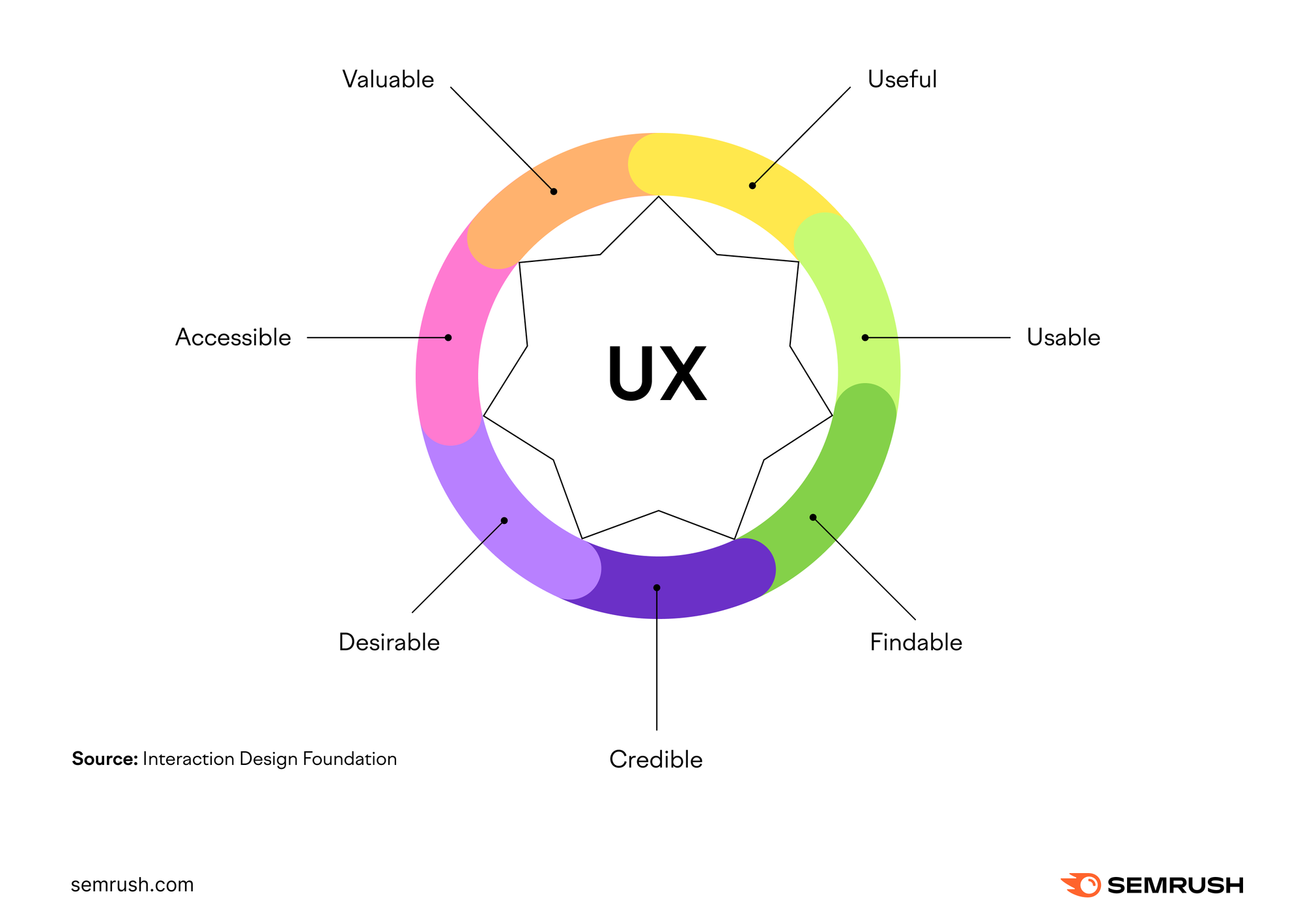
Neglecting UX correlates with lower conversion rates, high bounce rates, and less brand loyalty. Your business's bottom line suffers as a result.
But how much impact does it have?
According to Toptal, 88% of users are less likely to return to a website that offers a bad UX. Another study by PWC found that 32% of users will abandon a brand they previously loved after just one bad experience.
On the other hand, good UX can increase conversion rates by 400 percent.
Use these tips to optimize your ecommerce UX:
- Use a Content Delivery Network (CDN): CDNs allow users to connect to a server closer to their location. Deploying a CDN helps you deliver content faster.
- Optimize your visuals: Use plugins or free image compression tools to minimize image size and speed up your website
- Make your subheadings scannable: Use descriptive text to help visitors quickly grasp the page's content and determine its relevance to their needs
- Implement filters correctly: Have dedicated sections for filters and make them easy to select with a checklist option. Provide additional sorting options for easy navigation and a well-organized layout.
Linking Strategy
A linking strategy refers to creating connections between different pages or content within a website using URLs.
In the context of an ecommerce website, it involves strategically placing links on category pages to connect related products, improve navigation, enhance user experience, and boost SEO.
Follow these steps to create a good linking strategy for your website:
1. Internally Link Categories
Internally linking from broader categories to subcategory pages improves both site structure and user experience.
Additionally, category pages help distribute PageRank across the website.
PageRank measures a page's authority in search engines. As PageRank also counts internal links, a good internal linking structure can significantly impact SEO rankings.
Before we discuss developing an effective internal linking strategy for category pages, let's define category listing pages (CLPs) and product listing pages (PLPs).
CLPs refer to broader categories. A collection page for a broad category (Ex: shoes) will typically showcase all different types of shoes in one place.
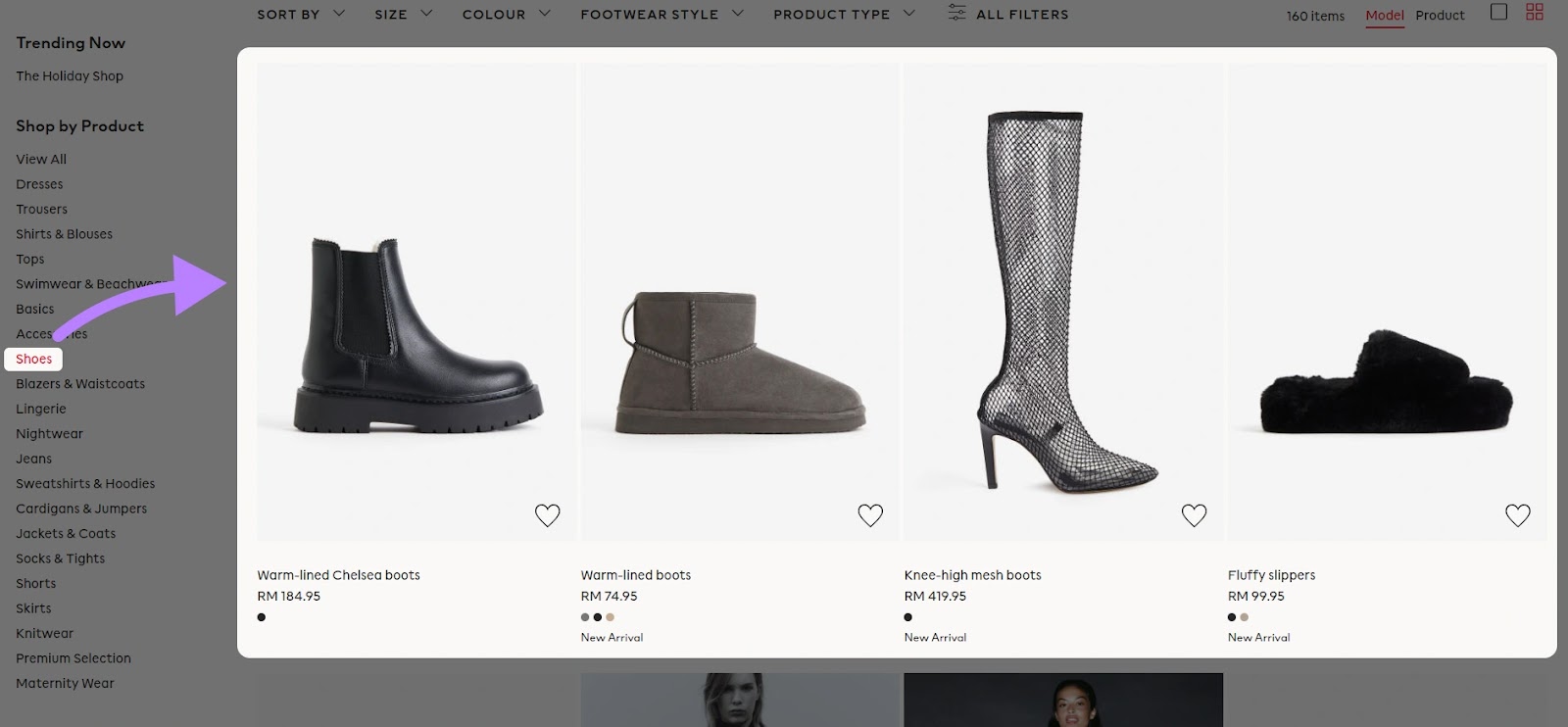
PLPs are sub-categories of products. For example, a collection of “boots” may have a category page under the CLP “footwear.”
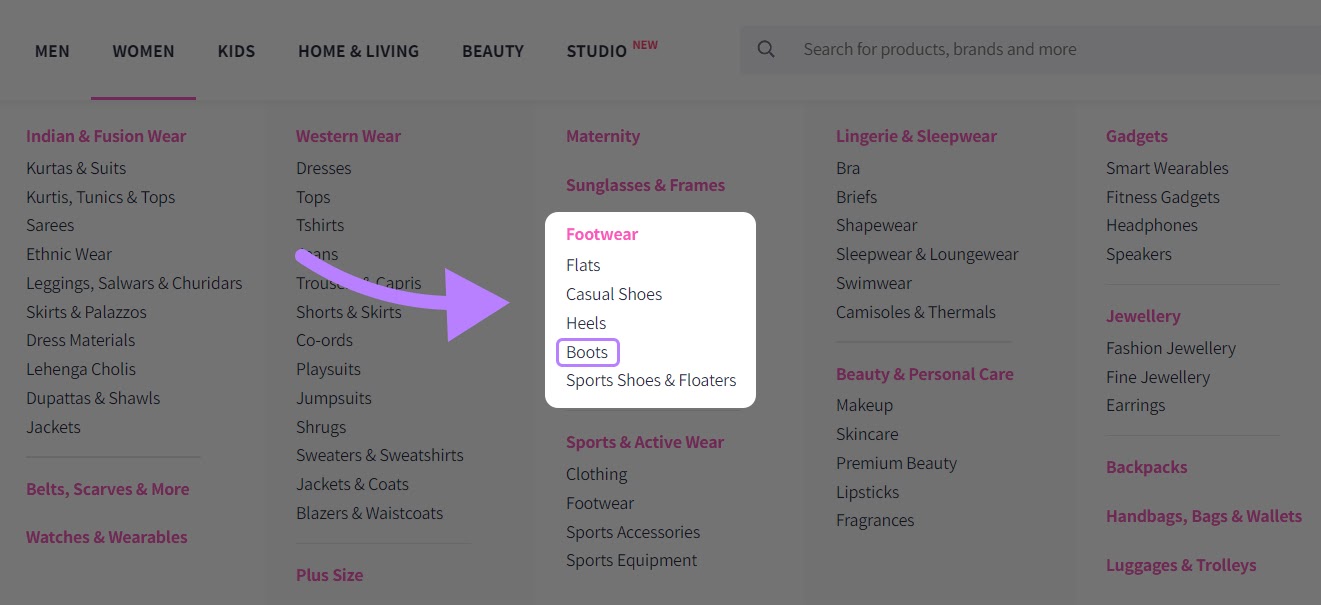
The parent-child relationship between a CLP (parent) and its PLPs (children) forms the basis of a good internal linking strategy for category pages.
When your website architecture includes parent-children relationships between CLPs and PLPs, you can automate your internal linking efforts.
For example, a developer can create a coding script on your website that recognizes when you add a new PLP and automatically links it to the right CLP.
You can also automate this type of hierarchical linking from product pages to the PLPs using a tool or plugin such as Yoast SEO or RankMath.
Large ecommerce websites can use custom scripts to do the same. A new product page will automatically link to the PLP, and the PLP will link to the CLP.
This can save you a lot of resources, especially if you run a large ecommerce store. You will also avoid creating orphan categories that have no links.
Parent-child internal linking creates a website hierarchy similar to the pyramid site structure search engines prefer. John Mueller from Google recommends this type of structure and says, “It helps Google understand the context of different categories and pages.”
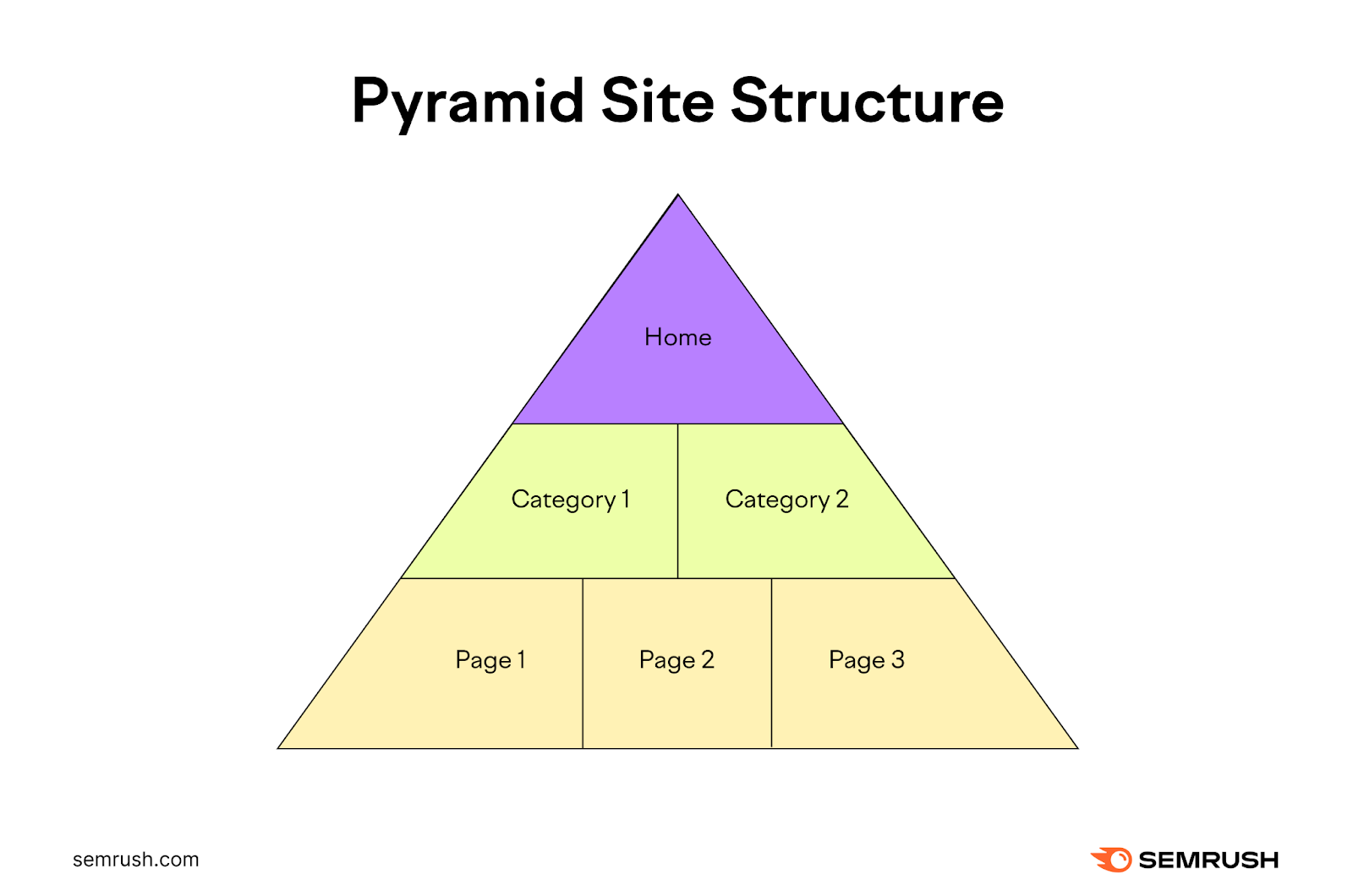
2. Manage Pagination
A cluttered website with many products on one page can overwhelm users.
Pagination (also known as paging) divides large categories of products into pages, typically in numerical order.
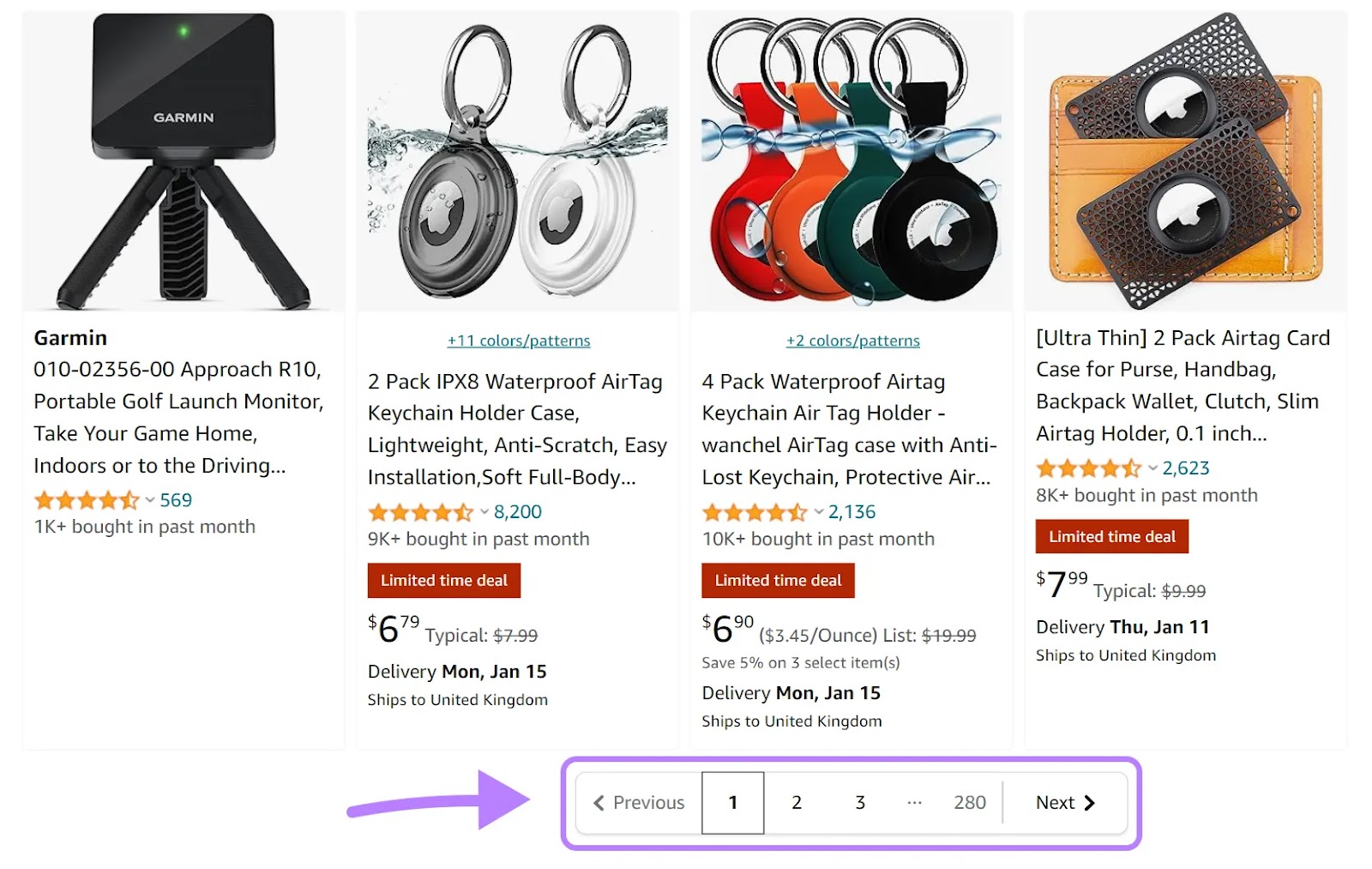
Pagination makes your website more user-friendly, which is also a ranking factor.
Here are tips to manage pagination:
- Focus on easy navigation: Page numbers are a must-have for managing pagination. Also, incorporate “next’ and “previous” buttons so shoppers can go back and forth between pages.
- Handle duplication with “a href” tags: Splitting a page into multiple discrete pages can create duplicate URLs. Because Google's crawler only follows links with <a href> tags, ensure none of the buttons have them. This will also prevent the crawler from triggering Javascript to update the content of the main page during crawling.
- Consider using “dynamic load” or infinite scrolling: Dynamic loading loads content without the user having to refresh the whole page, while infinite scrolling automatically shows more content as users scroll down. Combining this with pagination makes your website load faster.
Conversion Optimization
You have hundreds of website visitors, but they're not converting. How do you nudge them to add products to the cart and ultimately buy?
Use conversion optimization (conversion rate optimization or CRO) techniques to convert your existing traffic into customers.
Here's how:
1. Incorporate Conversion Optimization Elements
- Craft an effective call to action (CTA): Use clear and compelling CTA buttons to guide visitors toward desired actions like adding products to your cart or subscribing to your newsletter
- Use featured blocks: Highlight key products or promotions with featured blocks on the homepage or category pages to catch visitors' attention and encourage exploration
- Add sort and filter options: Allow users to sort products by price, ratings, and other attributes and practice faceted navigation
- Create customer surveys: Implement customer surveys to gather feedback on their website experience. Get insights on product and website improvements, ensuring the site meets user expectations.
- Streamline your payment process: Remove hurdles in the payment process to minimize friction during checkout. Simplify forms, offer multiple payment options, and provide a transparent and efficient payment pathway to boost conversion rates.
2. Continuous CRO Testing
No matter how much you optimize your website for conversions, there’s always more room for improvement. CRO tests (or A/B tests) evaluate how different page elements perform, such as copy, buttons, or banner placement.
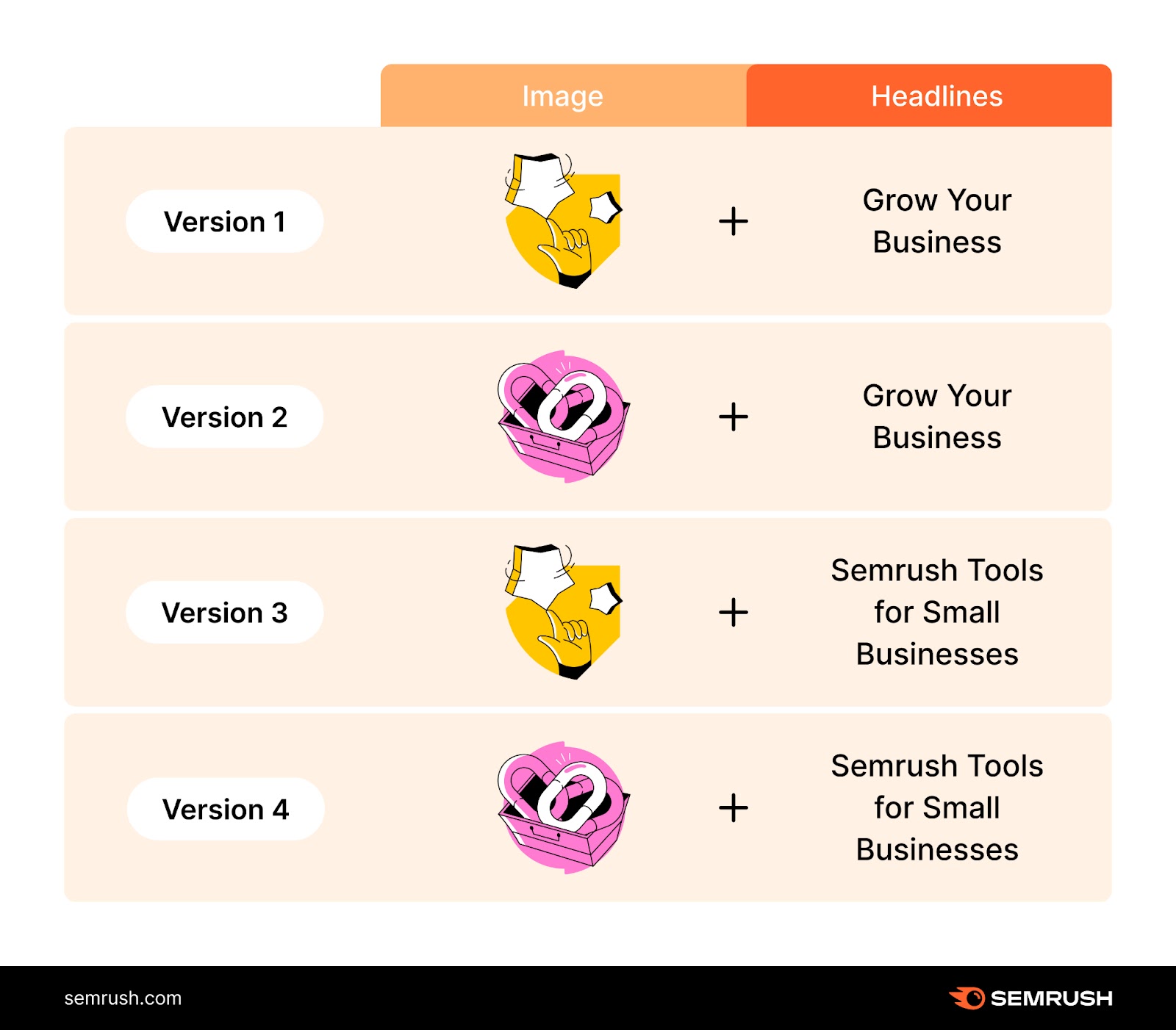
Test different page versions for visitors, and use the data to improve your website pages.
Read our What Is A/B Testing? A Comprehensive Beginners’ Guide to design your first CRO test.
Optimize Your SEO Ecommerce Category Pages for Success
We've already established that proper organization, long-tail categories, clear URL structures, and strategic content improve your ecommerce website category pages’ SEO.
The advice in this article is general, however. Your website needs might differ depending on your unique setup.
If you want to identify and fix SEO issues specific to your website, we recommend starting with the Semrush Site Audit tool.
